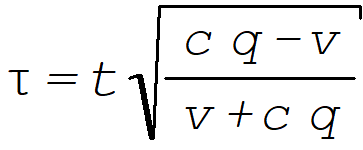Dear Horst,
1. Obviously there is a length contraction in xi direction, when v is in direction of +xi, but there is a length expansion in negative xi direction at the same time. This should make a big difference in observation, when, in the moving system k, a length is measured in backward direction. Is ths true?
The major axis of the ellipsoid in k is greater than the minor axis thereof; the minor axis in turn is equal to the diameter of the sphere in K. Thus the diameter is elongated by the Lorentz Transformation.
2. The theory of relativity would be consistent, if tau in eqs. (6) and (7) were identical. Replacing c by c*q with an adjustable factor q … assume that the factor q is identical with the inverse of n in your calculation.
Since n > 1, 1/n < 1, in which case the parameterisation by n would be ruined. Lorentz Transformation does not permit transformation of K system-time t to a system-time for k.
Kind regards,
Steve
| Virus-free. www.avg.com |
On Mon, Nov 4, 2019 at 8:55 AM Horst Eckardt <mail> wrote:
Stephen,
this is an highly interesting article, maybe revolutionary. I have a question and a comment.
1. Obviously there is a length contraction in xi direction, when v is in direction of +xi, but there is a length expansion in negative xi direction at the same time. This should make a big difference in observation, when, in the moving system k, a length is measured in backward direction. Is ths true?
2. The theory of relativity would be consistent, if tau in eqs. (6) and (7) were identical. Replacing c by c*q with an adjustable factor q then gives:
and
Equating both expressions gives a quadratic equation for q with solutions:
or, when the sign of v is changed:
I assume that the factor q is identical with the inverse of n in your calculation. For q=v/c we obtain tau=0, but for q=v/(2c) I obtain a complex-valued tau.
Nevertheless there is an the interesting point. Myron Evans had shown in UFT papers 324/325 that the deflection of light by gravitation can simply be explained by a gamma factor of
gamma = 1/sqrt(1 – v^2/(2 c^2)).
This gives gamma=sqrt(2) for v –> c. Thus it is possible that a photon has a mass despite of travelling with speed of light. This result may point into the direction of you findings.
Horst
Am 03.11.2019 um 10:59 schrieb Steve Crothers:
Crothers, S.J., Special Relativity and the Lorentz Sphere, http://vixra.org/pdf/1911.0013v1.pdf
ABSTRACT. The Special Theory of Relativity demands, by Einstein’s two postulates (i) the Principle of Relativity
and (ii) the constancy of the speed of light in vacuum, that a spherical wave of light in one inertial system
transforms, via the Lorentz Transformation, into a spherical wave of light (the Lorentz sphere) in another inertial
system when the systems are in constant relative rectilinear motion. However, the Lorentz Transformation
in fact transforms a spherical wave of light into a translated ellipsoidal wave of light even though the speed of
light in vacuum is invariant. The Special Theory of Relativity is logically inconsistent and therefore invalid.
Virus-free. www.avg.com







